
Sheaffer’s 1929-1941 Balance is a classic collectable pen. Company documentation for this series is amongst the best available for any period pen, and we are blessed today with at least nine catalogues, with key company brochures, and with innumerable advertisements. Collectors thus have a legitimately strong sense of Balance’s catalogued (and more broadly, documented) range. Off-catalogue variants are known, pens in particular with special cap-bands; this perhaps should not surprise us, given that the series was successful, long running and of high quality, with a large model range, manufactured by a major player involved in many markets. Such pens spice the collecting cholent no doubt. Balances with special cap-band styles offer challenges to collectors which include: identifying available variants, understanding their purpose(s) in the Sheaffer continuum, assessing rarity and cachet, and- no doubt- acquiring pens for personal collections. Here, we will address the first three challenges, within the context of catalogued typical variants. Regarding the fourth challenge, I fear you will have to hunt on your own for the actual pens; some secrets stay with me.
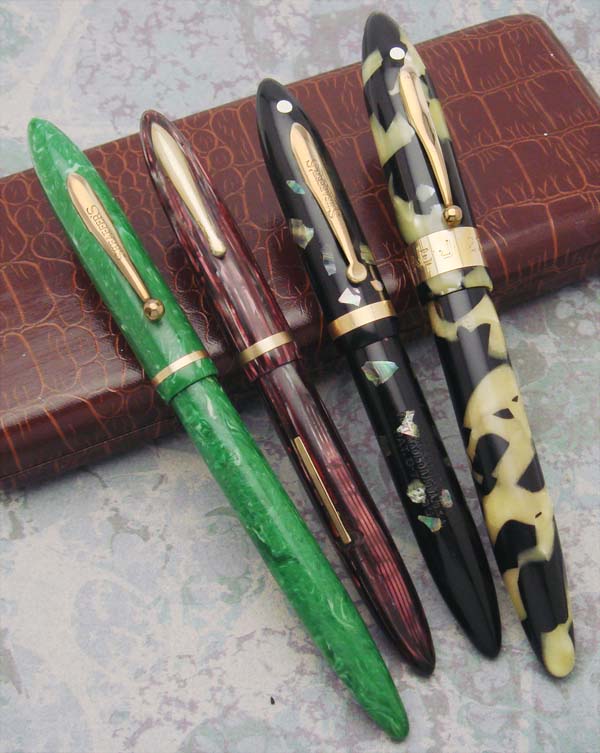
Period Sheaffer
catalogues show each Balance variant
with a single smooth cap-band, done either chrome
plated, gold-filled, or solid-gold, the
band’s size and composition
dependent on each pen’s tier-- its position
in the Balance hierarchy. Known
off-catalogue cap-band findings include: a)
patterned non-single (double or triple) cap-bands,
b) patterned single extra-wide (lined and
fish-scale) cap-bands, c) smooth but unusually
wide (or narrow) single cap-bands,
and d) solid gold cap-bands of typical size found
on pen colors (and even other series) not
catalogued with solid gold trim, essentially
“special-color” Autograph pens. I
suspect pens from first two categories
(patterned cap-bands) served a different purpose
than did the special color Autograph pens and pens
with cap-bands simply extra wide or narrow.
IMAGE 1. TYPICAL CAP-BANDS with CAPTION
Special clips are found on special cap-band pens, at least on those from the era of the flat-ball clip, supporting the notion that affected pens were dedicated products and not just simple cap-band upgrades. For catalogued pens the full-ball clip of 1929-1934 then the flat-ball clip from 1934-1935 (used through 1941 on lower tier pens) were imprinted “Sheaffer’s”, unlike the smooth radius clip used on higher tier pens from 1935 onward. The catalogued exception was the solid-gold-trim Autograph line, which had smooth (no “Sheaffer’s” imprint) full-ball and then flat-ball clips during the appropriate eras. While the earliest special cap-band pens-- those with full-ball clip-- had typical clips, by mid-late 1934 with the start of the flat-ball clip era, pens with off-catalogue cap-bands gained smooth clips, done thus in the style (but not the solid gold metal) of Autograph. Even late (1937-1941) striated color pens of the lower lines (still with flat-ball not radius clip) when found with off-catalogue cap-bands have smooth unimprinted clips.
When confronted by uncatalogued and/or otherwise anomalous pens, collectors variably invoke-- or perhaps retreat to-- a series of words that taken in their entirety can account for nearly any strange finding. A rapid fire sequence passes through the gray matter: “Prototype”, “Experiment”, “Frankenpen/Mixture”, “Transitional”, “Lunchtime Special”, “Niche Market” (eg. specific promotion, store, region or season), and “Special Order”. Some terms inherently are ambiguous. Some lend themselves to grandiose use, allowing the owner of said pen to embrace undue puffery. Some are well overused today. Most-- even if ultimately accurate for specific pens-- do not lend themselves to easy proof. Fortunately, we readily can dismiss several from subsequent consideration.
That the double band, the triple band, and the wide non-smooth bands were used for years argues overwhelmingly against prototype or experimental goals and argues against the infamous lunchtime special notion, the idea that factory line workers with too much time on their hands created anomalies just… because. While caps, barrels and nibs often can be mixed inappropriately by collectors, mixes cannot explain the very existence of pens with these cap-bands, as no potential donor pens exist; too there is huge physical challenge to swapping cap-bands . We are left it seems with the concepts of niche market and of special order. Niche markets might have included the annual holiday season, a particular geographic region, a category of store or even a particular store chain, thus explaining the very low prevalence double, triple, and fish scale cap-bands and the merely relatively uncommon lined “jewelers” cap-bands.
Special order/special purpose notions go a long way to explain smooth but extra wide or unexpectedly narrow cap-bands as well as the findings of solid-gold (Autograph) trim on special color pens and even on Sheaffer pen-pencil Combos. Customers (end users) could have requested special variants, perhaps from special order lists lost to history. Pens meant for awards or for advertising might have had special features. Most of this of course is speculative, but it is a start, and it provides context for further discussion.
 The collector-named Jeweler’s
cap-band-- single, extra wide, with milled
(lined) pattern-- overwhelmingly is the most commonly
found off-catalogue cap-band; it is the one for which the
most available (though still quite sparse) Sheaffer
documentation exists. Whilst a detailed
treatment of the Jeweler’s cap-band would warrant a
dedicated article, we can cover the basics and explore a
couple quirks. Along with several other patterns, it makes
its first appearance perhaps as early as mid-late
1934, as it is found on Gray Pearl #1 (gray-red) and
Ebonized Pearl pens with flat-ball clip, the flat-ball
clip first mentioned by Sheaffer in August 1934. It is
found on all subsequent colors and even appears on the
1941 military-clip Balance, giving a 1934-1941 run.
The collector-named Jeweler’s
cap-band-- single, extra wide, with milled
(lined) pattern-- overwhelmingly is the most commonly
found off-catalogue cap-band; it is the one for which the
most available (though still quite sparse) Sheaffer
documentation exists. Whilst a detailed
treatment of the Jeweler’s cap-band would warrant a
dedicated article, we can cover the basics and explore a
couple quirks. Along with several other patterns, it makes
its first appearance perhaps as early as mid-late
1934, as it is found on Gray Pearl #1 (gray-red) and
Ebonized Pearl pens with flat-ball clip, the flat-ball
clip first mentioned by Sheaffer in August 1934. It is
found on all subsequent colors and even appears on the
1941 military-clip Balance, giving a 1934-1941 run. It is found in two sizes, the narrower (which lacks cartouche for personalization) generally associated with the lower couple Balance tiers particularly with pens of slender size. The wider variant (with cartouche) is far more prevalent today, and is found on pens of all three diameters, generally of the top two tiers, sometimes with features that blur the lines that separate Balance’s typical catalogued models/tiers.
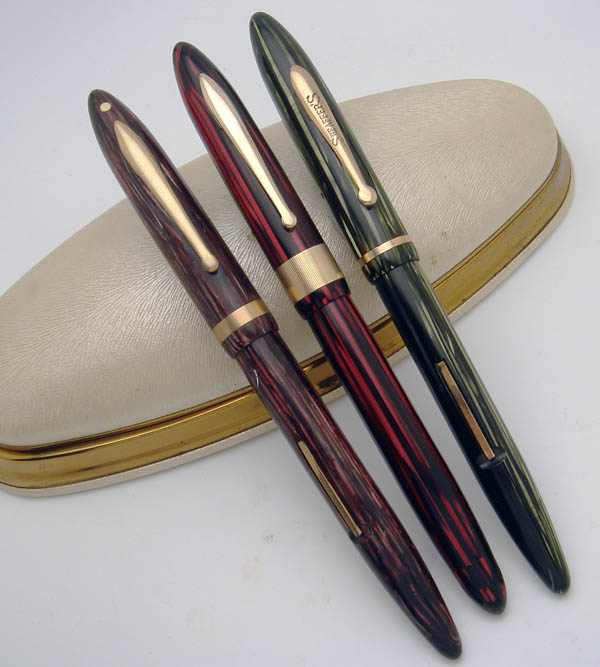 Consider the
Sheaffer Balance Mercury, a Jeweler’s cap-band
pen, one of very few for which we have an
actual model name. Mercury is not merely the result
of a cap-band upgrade to a typical model. This
late-era Balance is full length and slender,
lacks the top-tier White Dot and
features the late era Radius clip common to
the top two Balance tiers ( those with
Lifetime or Feathertouch nibs). Mercury-- save
for the fancy cap-band-- would seem then to have a
classic/typical 2nd tier cap (Radius Clip, non White
Dot) save that no 2nd tier pen with regular cap-band
in fact ever was catalogued in this particular
size. Long Slender pens were catalogued
with radius clip but only then with the White Dot,
as the first tier Balance Sovereign. The other
catalogued long slender pens from this era are the
non-radius clip third tier Craftsman (non White Dot,
flat-ball clip) and the low-line Junior. That
Balance Mercury, even ignoring the special cap-band,
has special and off catalogue cap features
demonstrates Sheaffer’s special intent for this pen.
. Special model name. Special cap-band. Special
additional cap features.
Consider the
Sheaffer Balance Mercury, a Jeweler’s cap-band
pen, one of very few for which we have an
actual model name. Mercury is not merely the result
of a cap-band upgrade to a typical model. This
late-era Balance is full length and slender,
lacks the top-tier White Dot and
features the late era Radius clip common to
the top two Balance tiers ( those with
Lifetime or Feathertouch nibs). Mercury-- save
for the fancy cap-band-- would seem then to have a
classic/typical 2nd tier cap (Radius Clip, non White
Dot) save that no 2nd tier pen with regular cap-band
in fact ever was catalogued in this particular
size. Long Slender pens were catalogued
with radius clip but only then with the White Dot,
as the first tier Balance Sovereign. The other
catalogued long slender pens from this era are the
non-radius clip third tier Craftsman (non White Dot,
flat-ball clip) and the low-line Junior. That
Balance Mercury, even ignoring the special cap-band,
has special and off catalogue cap features
demonstrates Sheaffer’s special intent for this pen.
. Special model name. Special cap-band. Special
additional cap features. Too, during this era all catalogued radius-clip pens without White Dot had the Feathertouch #5 two-tone nib, yet the long/slender Mercury along with its short/slender sister, Diana, have lower tier #3 nibs. With respect specifically to clip vs nib, these two pens thus blend typical features from both second and third tier Balances. Far too many are found with this feature mix to explain away the nib as aftermarket collector swaps.
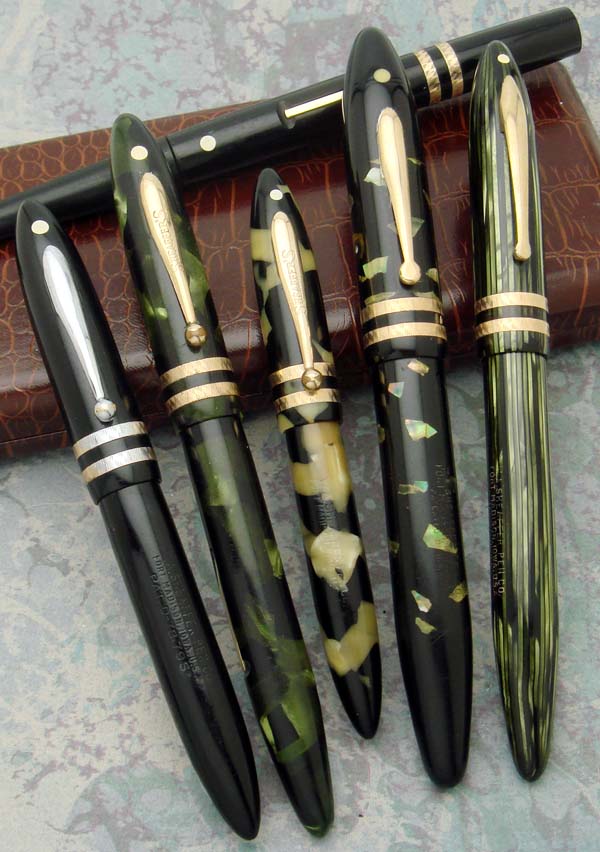 The very
scarce double decorative (double deco) cap-band
appears on pens from ~1931 through at least 1938, possibly
through the end of Balance’s run in 1941.
Pocket pens so far are wholly undocumented, but a single
bit of Sheaffer literature does show this band pattern on
the barrel of a desk pen , appearing in
Sheaffer’s October 1931 Retailer's Review, in
a section targeting sales by… jewelry shops. Pens
are found starting with early colors including
Black-and-Pearl and the first Marine Green
(mottled). All the Black-and-Pearl full length pens
I’ve seen so far have normal length barrels,
not the extra-long barrels found with very first of
the early-era Balances from 1929-30. The full-ball
clips, matched as expected to pens with early-era
colors, are of the typical catalogued
“Sheaffer’s”-imprinted sort. Special smooth
(no “Sheaffer’s” imprint) flat-ball clips are found
in the 1934-1935 flat-ball clip era. Once the
radius clip took over in 1935 for the upper two tiers, if
any of these were released in lower-tier trim (which still
would have flat-ball clip), I’d expect to find smooth
flat-ball clips for them.
The very
scarce double decorative (double deco) cap-band
appears on pens from ~1931 through at least 1938, possibly
through the end of Balance’s run in 1941.
Pocket pens so far are wholly undocumented, but a single
bit of Sheaffer literature does show this band pattern on
the barrel of a desk pen , appearing in
Sheaffer’s October 1931 Retailer's Review, in
a section targeting sales by… jewelry shops. Pens
are found starting with early colors including
Black-and-Pearl and the first Marine Green
(mottled). All the Black-and-Pearl full length pens
I’ve seen so far have normal length barrels,
not the extra-long barrels found with very first of
the early-era Balances from 1929-30. The full-ball
clips, matched as expected to pens with early-era
colors, are of the typical catalogued
“Sheaffer’s”-imprinted sort. Special smooth
(no “Sheaffer’s” imprint) flat-ball clips are found
in the 1934-1935 flat-ball clip era. Once the
radius clip took over in 1935 for the upper two tiers, if
any of these were released in lower-tier trim (which still
would have flat-ball clip), I’d expect to find smooth
flat-ball clips for them.Their absolute rarity limits discussion of relative rarity among different colors, given that fewer than ten of these are widely known in most colors, counting all the known great collections, save-- perhaps-- for the mottled Marine Green, which in my experience is the most prevalent color with this cap-band. Though tending to be an early to middle era finding, in fact the double cap-band survives into the late Balance era and has turned up on radius clip pens done in striated colors. I know of a grand total of two late color pens amongst numerous possible sizes, colors and trim tiers. I own a standard size striated Marine Green pen and have seen image of a slender striated Gray Pearl pen. Rare, baby.
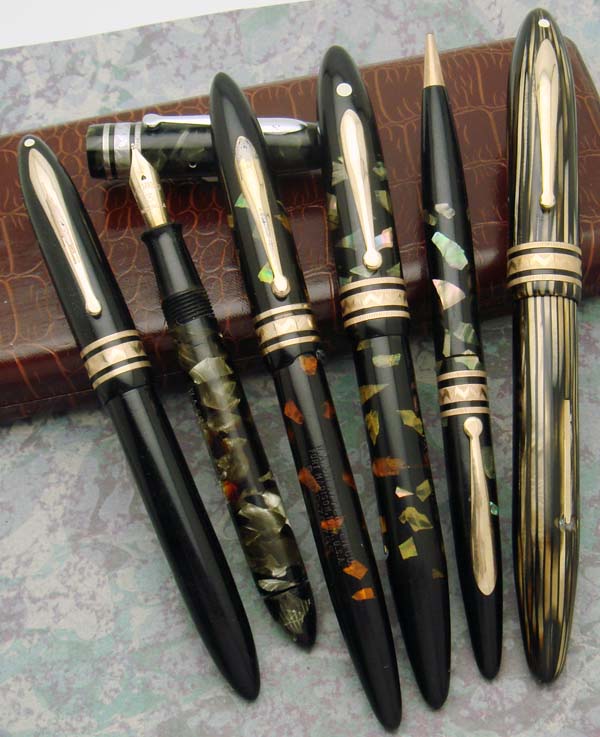 Triple decorative
(triple deco) cap-band pens (thin-fat-thin) seem to be--
all told-- more scarce than the double cap-band pens,
though limited sample again muddies that assessment.
I’ve seen none on Marine Green, Black/Pearl, and Blue
pens, and the earliest pens date to mid-late 1934,
found with flat-ball clip on the first Gray Pearl
(gray with red veins) and on Ebonized Pearl. All
flat-ball clip pens have the special smooth clip.
This pattern did make it to the late (striated plastic)
era, appearing on at least one brown oversized pen, a
color which in general ran 1937-1941, yielding a
production run for this style cap-band of 1934
to 1937+. I’ve seen just one pen in striated plastic.
Triple decorative
(triple deco) cap-band pens (thin-fat-thin) seem to be--
all told-- more scarce than the double cap-band pens,
though limited sample again muddies that assessment.
I’ve seen none on Marine Green, Black/Pearl, and Blue
pens, and the earliest pens date to mid-late 1934,
found with flat-ball clip on the first Gray Pearl
(gray with red veins) and on Ebonized Pearl. All
flat-ball clip pens have the special smooth clip.
This pattern did make it to the late (striated plastic)
era, appearing on at least one brown oversized pen, a
color which in general ran 1937-1941, yielding a
production run for this style cap-band of 1934
to 1937+. I’ve seen just one pen in striated plastic.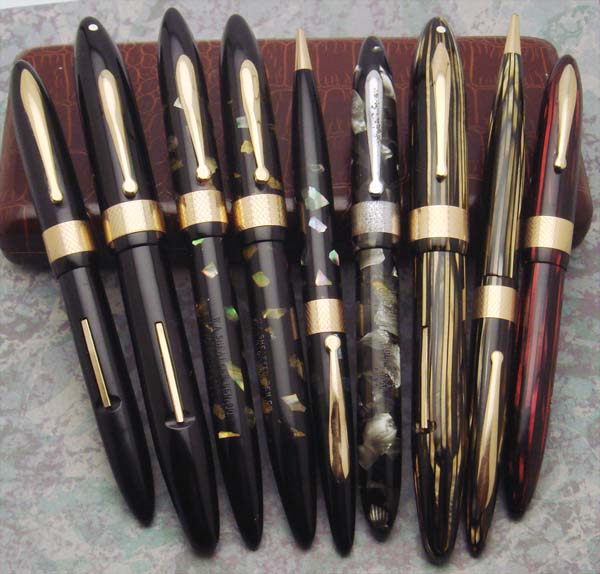
Perhaps more scarce than the double cap-band though seemingly a bit less rare than the patterned triple cap-band is the extra wide patterned single band called fish-scale by collectors. This appears on White Dot and non White Dot models, ranging from slender to oversized. As with the jeweler’s cap-band and the triple cap-band t he earliest colors I’ve seen-- again-- are the red-veined gray and Ebonized Pearl, accompanied by the flat-ball clip, the clip itself special in lacking the “Sheaffer’s” imprint. The subsequent mottled gray/black (Sheaffer’s Gray Pearl #2) is found as are late era (striated) colors so far including Carmine, Marine Green and Brown. The cap-band thus was used at least 1934-1939 or so, possibly later. This cap-band was the last of the off-catalogue USA-sourced styles I discovered, my first encounter being an oversized Ebonized Pearl set I unfortunately did not purchase at the time due to price . I do harbor some regrets, as I’ve never seen another in this size/color.
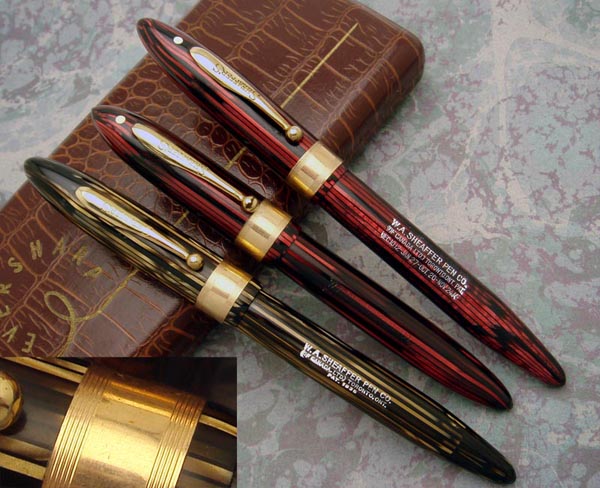
Sheaffer in Canada does appear to have had a minority Balance cap-band uniquely its own, wide and smooth save for a few circumferential lines at top and bottom. I’ve also seen the double deco band on Canadian pens, and have seen a questionably Canadian wide-milled “Jeweler’s” cap-band pen, noting that a long time Sheaffer collector has claimed to have seen other milled-band Canadian Balances. I’ve yet to see triple band or fish-scale cap-band Canadian pens, though that does not not preclude their existence.
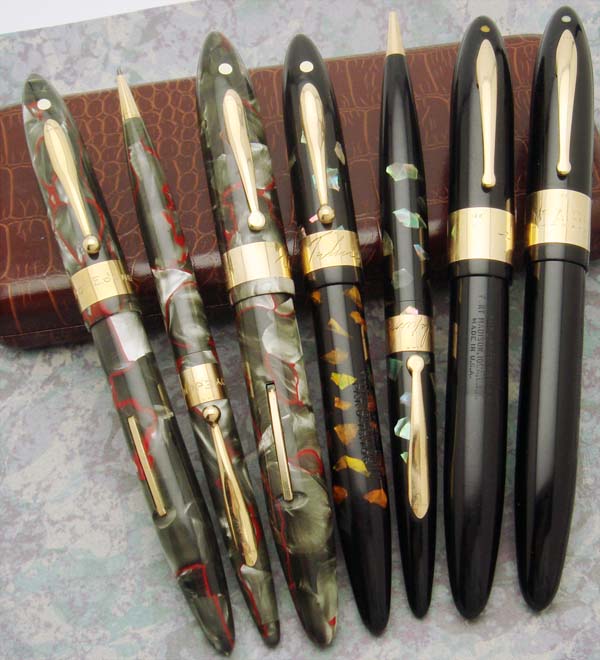
Catalogued pens from Balance’s Autograph line each have a single, wide, solid 14 karat gold cap-band, usually with a solid gold clip as well. The first known Balance catalogue from 1930 shows such pens in black, Marine Green (mottled) and Black/Pearl. Later catalogues show black alone. Cap-bands all are the same width, independent of pen size. However, Autograph Balance pens occasionally are found in off-catalogue colors, or with cap-band wider than the catalogued size. I’ve seen off-catalogue Autograph pens in red veined gray (Sheaffer’s 1st Gray Pearl), in Ebonized Pearl, as well as just one oversized example in striated Brown Pearl and just one 1941 military-clip pen in Carmine. Perhaps other colors will emerge. These certainly could have been easy special order items back in the day. Perhaps one day we will find a Sheaffer pamphlet declaring, “Autograph style pens in other colors available at customer’s request”. Certainly the “Rudee Vallee” Autograph Sheaffer Combos support the notion of special order special color Autographs. Too, we see frankly rare Autograph pens with extra-wide cap-band. All I’ve seen have been oversized pens done in black celluloid.
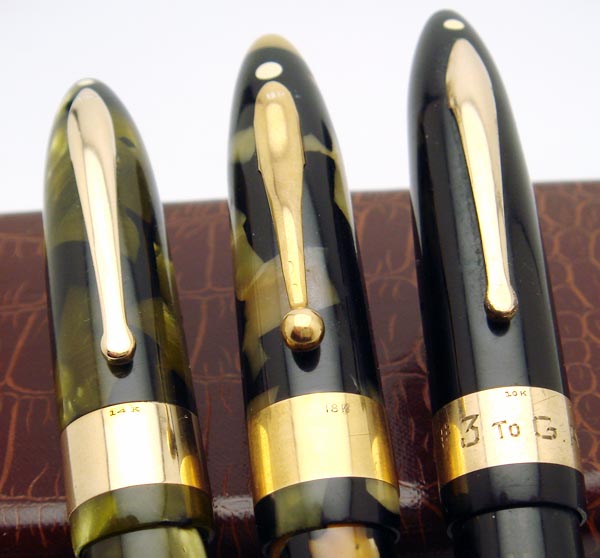
All catalogued Autograph type (solid gold trim) Balances have 14 karat trim. Rare pieces exist with gold trim that is not 14k, though (so far) still of typical width; I own one and have heard of maybe a couple others done in 18k trim. While the pens carry no other special markings, collectors have hypothesized these were meant for the French market, where items reportedly could not be offered as solid gold if < 18k. Still, while my for-France Parker Vacumatics have 18k-marked nibs, the only 18k-trim Balance I own has no visible special markings on what might be a typical 14k nib. Recently I stumbled onto my first 10-k Autograph, this one having a gold-filled clip.
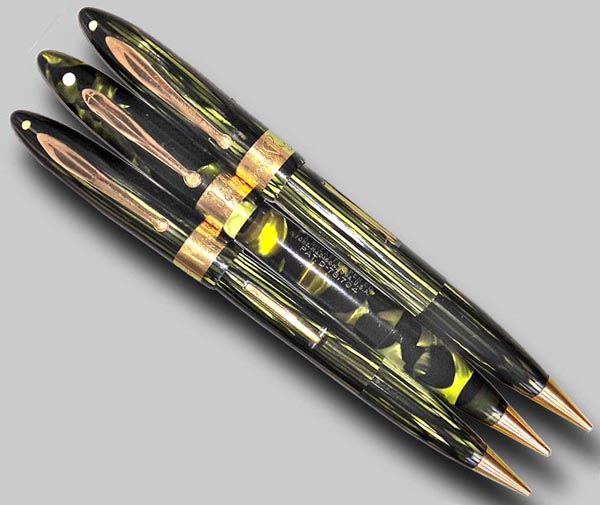 The "Rudy" Sheaffer
Combo Autograph Pens.
The "Rudy" Sheaffer
Combo Autograph Pens.If ever there were a Balance that argues for "special order" vs simply for niche/limited market it is the "Rudy" Sheaffer Combos. Combos were catalogued in 1930 in three colors and in 1935 in black alone. All were shown as non-lifetime (non-White dot) pens. Off-catalogue White Dot pens are known, and they are relatively uncommon. Where things get a bit crazy is with the Autograph (solid gold cap-band and clip) Combos. A mere handful are known to the hobby, and nearly all (perhaps truly all) are marked "From Rudy". Hobby mythos is that the Rudy is crooner Rudy Vallee, who was in his thirties during the 1930's, that these were special order by him as gifts to friends and associates. Whether or not Mr. Vallee was the Rudy in play, that these are overwhelmingly rare and that essentially all are marked from a specific gift giver provides overwhelming support for "special-order" status, and lends support to the other special-color Balance Autographs being special order as well. The "Rudy" Autograph combos are known in both Marine Greens, the mottled dating to earliest mid-late 1934 in view of the flat-ball clip (smooth, as the pen is an Autograph), to at least 1937, as that is when the striated version first appeared, that color running through 1941 for Balance.
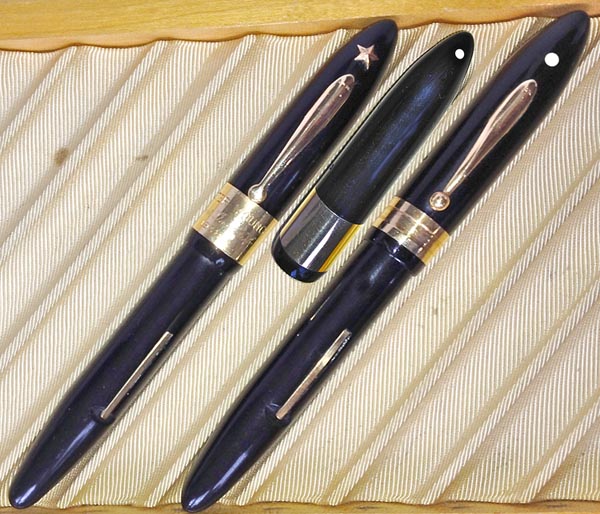
A couple final Autograph pens that scream "special order." The Autograph pen at left (given as an award) has an extra-wide cap-band similar to pens seen in an earlier photo. One might imagine the gold star replacing the usual white dot could be after-market. But no. The reverse side of the same cap is shown next to it (in montage), with the typical white dot located on opposite side of cap, clearly placed there at time of manufacture to allow preservation of white-dot status, while leaving room for the special gold star. The pen at right also is an Autograph. The cap-band is typical girth but has raised rims thus with an overt indentation centrally. I have not handled this pen, but assuming original product, it is so far one of a kind and again screams, "special order"
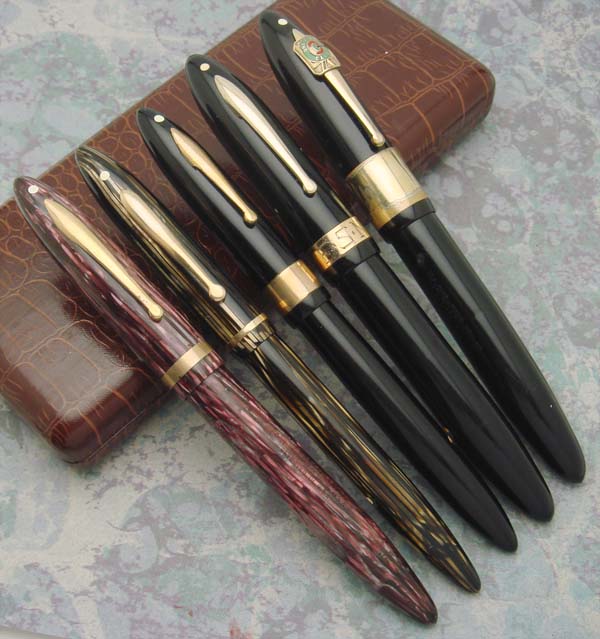
Black Balances with gold-filled trim with extra-wide single cap-bands have been found, with more than one off-catalogue width known. I’ve seen just one with a moderately wide cap-band, found in fact while I was writing this article; it is of same size as a known extra-wide but also undocumented cap-band found on a much earlier flat-top Sheaffer. An ultra-wide band has been found on an award pen of sorts-- something that screams “special order”-- given by an insurance company to a successful salesman. In addition to the band inscribed with the award, the clip features a crimped company logo.
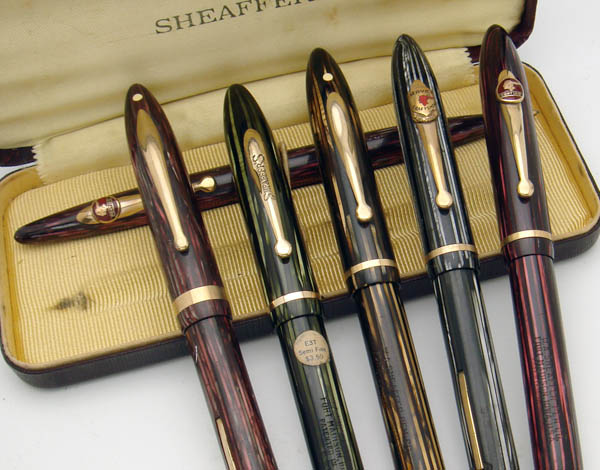 Also noted are
some slender pens with white dot but with extra-thin
cap-band usually found on low-tier pens.
They seem to blend the 1st-tier Sovereign (White Dot and
Lifetime nib) with the 3rd-tier Craftsman (thin
cap-band, flat-ball clip), with the added tell that the
flat-ball clips are smooth lacking the expected
“Sheaffer’s” imprint, indicated a "special-purpose"
flavor. The brown pen at middle of image is
such a pen. Period Sheaffer pens made for
advertisement or for company logos have been found with
the smooth flat-ball clip (making a close match to the
"blend" pen) but all found so far are non-White
Dot. Purpose for these is unknown and accident is
not excluded, though enough turn up to disfavor
accident. Could White-Dot pens meant for the company
logos have been produced? Could the blend pen be
such a pen, one that failed to receive the necessary
advertising/company imprint and/or badge? Could
leftover pre-advertising pens have been fitted with
white dot to get rid of them? Seems like too much
hassle. Or could they have served another imagined
purpose, say serving as pens for internal consumption,
given or sold to Sheaffer employees only, allowing
easy tracking of pens, as they differed then from any
sold to the public? I... don't... know.
Also noted are
some slender pens with white dot but with extra-thin
cap-band usually found on low-tier pens.
They seem to blend the 1st-tier Sovereign (White Dot and
Lifetime nib) with the 3rd-tier Craftsman (thin
cap-band, flat-ball clip), with the added tell that the
flat-ball clips are smooth lacking the expected
“Sheaffer’s” imprint, indicated a "special-purpose"
flavor. The brown pen at middle of image is
such a pen. Period Sheaffer pens made for
advertisement or for company logos have been found with
the smooth flat-ball clip (making a close match to the
"blend" pen) but all found so far are non-White
Dot. Purpose for these is unknown and accident is
not excluded, though enough turn up to disfavor
accident. Could White-Dot pens meant for the company
logos have been produced? Could the blend pen be
such a pen, one that failed to receive the necessary
advertising/company imprint and/or badge? Could
leftover pre-advertising pens have been fitted with
white dot to get rid of them? Seems like too much
hassle. Or could they have served another imagined
purpose, say serving as pens for internal consumption,
given or sold to Sheaffer employees only, allowing
easy tracking of pens, as they differed then from any
sold to the public? I... don't... know. What Sheaffer information do we have for these off-catalogue pens? Well.. remarkably little. By definition, no pen appears in any known catalogue. I know of one illustrated reference to the double band pattern-- though only as barrel bands for a desk pen, not cap-band for pocket pen-- in Sheaffer’s October 1931 Retailer’s Review; beyond that, I know of tiny snippets of company material just for the lined Jeweler’s cap band--only for the wider of the two styles. (mention that in 1931 sheet, the double band is mentioned in the Jeweler’s section but only mention it in the image caption)
For the Jeweler’s cap-band, information both precious and scarce is found in a couple adverts, in price codes on pen barrels, in model codes and prices on clip tags, and in model names on foil labels in boxed sets and on barrel stickers. My admittedly vague recollection is that the adverts that show the Jeweler’s band do not reference it by special description or by special price; the illustration is… incidental.
Starting perhaps in 1937, Sheaffer marked pen prices (in cents) on pen barrels (e.g.. “1000” is found heat stamped on $10 Premier and Statesman models), and it introduced model names for Balance pens also quite late, in 1938. Thus for pens starting 1937-1938 there is potential now to find novel barrel price imprints and novel model names for special cap-band pens. While nearly all Jeweler’s cap-band pens-- even with late era colors -- lack barrel price codes, rare price-coded examples have appeared; the prices found are greater than for related typical catalogued pens. A couple price-tagged pens have turned up, confirming model codes unique to this special cap-band and reflecting/confirming the higher price point for at least some of the special cap-band pens. I know of four late-era special model names based on foil tags in boxed sets and on barrel stickers, names never used for catalogued siblings. This information is golden. (See Image X) The existence of formal model codes and model names argue again that the special cap-band pens were not just special order items, but were dedicated products, intended for at least limited retail sale.
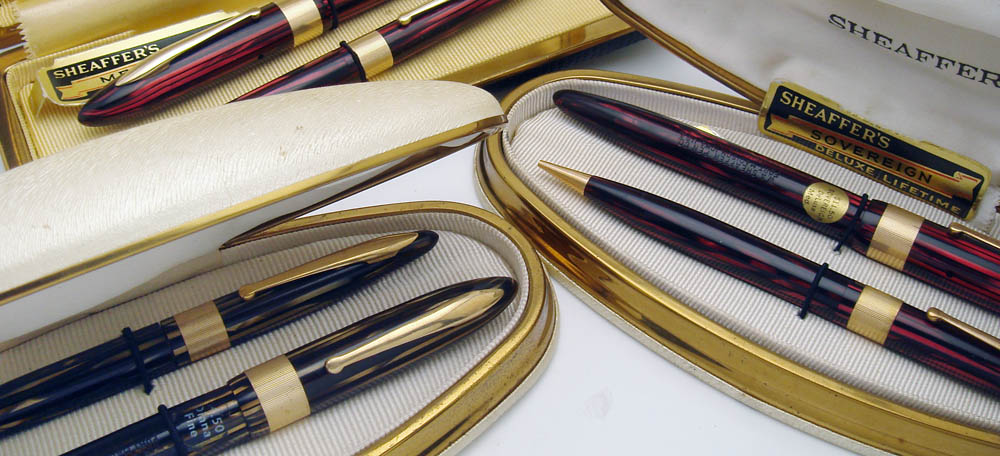
What to call this extensive cluster of off-catalogue Balances, besides… well.. uncatalogued or off-catalogue ? Currently, nothing more is necessary. Some object, however, noting that discovery of even a single pertinent catalogue would invalidate these descriptors. True enough, though with 35 years of hobby research having failed to procure such paper, the risk is modest, and too there are worse things than having to change a descriptor in the face of new information once per generation. Indeed, I’d be quite content terminating these pens’ off-catalogue status to celebrate the discovery of a targeted catalogue. For those who favor more generalized terminology or have overriding issues about “catalogued” status, one instead can label all these as special cap-band pens, subject to debate of the import of “special”. One fellow likes fancy cap-bands to describe the patterned bands. If we wish overwhelming generality, I suppose we could call all these minority cap-bands. There have been rumblings to broaden the “Jeweler’s Band” label from specific use for the vertically lined wide bands to include instead all the special-pattern (double, triple, fish-scale, maybe Canadian lined-edge) cap-bands , based on suspicion such pens were offered specifically to a segment of the retail jewelry market, though this is not yet proven and though there would be significant collector convention to overcome in using that label for anything beyond the milled-band pens. I do consider the pens we’ve examined to fall into two broad groups, the first composed of the non-smooth patterns: double, triple, fish-scale, and lined, pens that likely were niche market, the second group comprising cap-bands still smooth just extra-wide or narrow or found on off-catalogue colors, pens that might have been special order or special purpose.
Image X (star award pen courtesy of Pat Mohan)
The off-catalogue pens range from relatively uncommon to overwhelmingly rare, noting that the following personal observations carry the caveat that of course I do not know all pens in all private collections. Save for the vastly more prevalent Jeweler’s cap-band, many patterned (double, triple, fish-scale, edge-lined Canadian) cap-band size/color variants are frankly rare, currently with just one or a few known or so far unknown altogether. Amongst thousands of Balances seen or handled, I doubt I’ve encountered even thirty pens total with the triple band or with the fish-scale band, counting all pen sizes and colors. I have personally seen just three of the edge-lined Canadian cap-band pens. Smooth extra-wide single cap-bands are just a few total known to the hobby and appear so far only on black pens. Even the jeweler’s cap-band sees some quite scarce variants. Special color Autograph (solid gold trim) pens no doubt gain in value and cachet; they are quite scarce, with few known in each of just a few size/color combinations.
As with most esoteric findings for old pens, the added economic value from the funky cap-bands is disproportionately small compared to their relative or absolute scarcity. I consider the special cap-band Balances to be under appreciated… exotic sleepers in the Sheafferverse. The Jeweler’s cap-band, as with a similarly named lined off-catalogue cap-band found with competitor Parker’s Vacumatic series, in general adds at least a modest value bump. Other cap-band findings should add more value… but sometimes don’t. The collector currently willing to pay 125% to, oh, 250% the price of otherwise typical pens can buy pens seen just one per hundred or one per thousand typical siblings… or even “none previously identified”.
That this is the first formal survey of this Sheaffer exotica demonstrates that our 35 year old hobby still offers space for fresh research. I invite future commentary from readers of this article, as I’m now a bit burned out on this subject. It is my hope that this text will be the springboard for future research by others and will prod collectors to examine their holdings and to come forth with new information. Oh… and yeah… if you happen to have spare special cap-band pens my collection needs, do drop me a note.